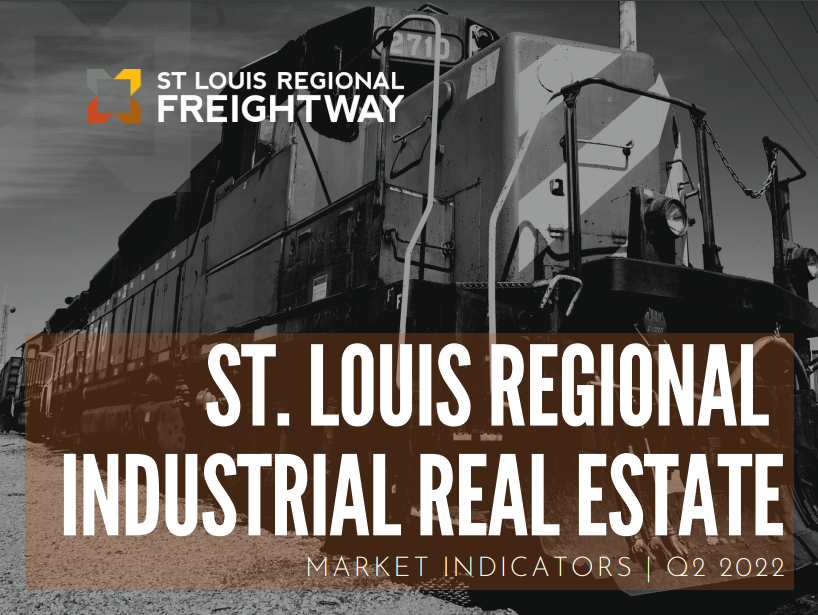
St. Louis Regional Freightway’s Q2 Industrial Market Indicators Report highlights noteworthy data for the region
The St. Louis region’s industrial real estate market continues to rise to meet the demand for modern bulk and manufacturing spaces with record levels of construction. The annual report released by the St. Louis Regional Freightway reveals the southwestern Illinois and eastern Missouri region has nearly 8 million square feet (MSF) of modern bulk buildings under construction and is well positioned to meet the current and growing needs of distributors and developers. The level of speculative development in the region also is indicative of the strength and value of the market, as is the growing number of major national institutional grade owners with a presence in the region.
The St. Louis Regional Real Estate Market Indicators & Workforce report focuses on bulk industrial buildings that are vital to the freight and logistics supply chain. It presents key trends and statistics for the St. Louis region and highlights its competitive advantages in the areas of freight and distribution.
Key Takeaways from the Report
- Modern bulk distribution buildings under construction hit the historic high of 7.81 MSF, which is 54% higher than the five-year average and 90% higher than 2021.
- Construction activity is high on both sides of the Mississippi River in Illinois and Missouri with the highest concentrations occurring in North St. Louis County, Missouri (36.5%), Madison County, Illinois (33.0%), and St. Charles County, Missouri (19.3%).
- Speculative construction activity levels are at 7.8 MSF for 2022, accounting for 100% of the modern bulk construction projects currently underway. This is higher than the speculative activity in the region in 2019, 2020, and 2021 combined, a clear indication that developers believe the St. Louis market is a solid place for industrial growth and investment.
- The number of major national institutional grade owners investing in property in the region has grown to 34, up from 19 in Q2 2021.
- As construction surges to meet the growing demand for warehouse spaces, industrial sites with valuable rail access potential have entered the market.
Featured Corridors
The report highlights two corridors in the region that demonstrate impressive metrics. Interstate 70 (I-70) in the St. Louis region is a vital freight transportation corridor supporting the global supply chains for the aerospace, automotive, agricultural industries. More than $133 million in infrastructure projects are funded along that significant corridor to improve the route and support the economic drivers located along it. One of those drivers is True Manufacturing, where Chester Jones serves as Manager of Supply Chain Operations.
“Our headquarters sits right off I-70 here in O’Fallon [Missouri] and we often say here that I-70 is the heartbeat of True Manufacturing. With facilities located to the west in Mexico, Missouri, then down south in Pacific, Missouri and north in Bowling Green, Missouri, we traverse I-70 with about 88 trucks per day going between the headquarters facility and those facilities. So, it’s key for us to have ease of access and the ability to move quickly throughout the area.”
The second highlight is the Illinois Route 3 corridor. It spans from north of Alton in Madison County to south of Waterloo in Monroe County and remains a thriving hub for manufacturing and logistics that generate more than $16 billion in annual business revenue and support 221,881 direct and indirect jobs. It is optimized for manufacturing and logistics with the heavy infrastructure and multimodal access needed for industrial growth.
“Our spotlight on the Illinois Route 3 corridor reveals it attracts workers from more than 1,000 different zip codes across three states and the workforce is more concentrated within the manufacturing and transportation/warehousing industry than both the region as a whole and the nation, which highlights the accessible and highly skilled workforce that keeps this heavy industrial corridor thriving,” said Allison Gray-Gunsten, Vice President, Steadfast City Economic & Community Partners, which developed the report.
The Featured Real Estate Sites Map in the latest report shows the location of dozens of prime industrial sites across the bi-state region, including those that are served by rail. The map can be found on the St. Louis Regional Freightway’s Website at https://www.thefreightway.com/real-estate/.
The report also highlights other advantages that reinforce the St. Louis region’s unique position as One Location with Global Access, including the presence of six Class I railroads, five airports with capacity, four interstates with national access, and America’s third largest inland port, which is home to the Ag Coast of America.
“We have 77.5 million square feet of modern bulk inventory that we continue to add to, and it’s all supported by a world-class freight network and an industry leading labor force,” said Mary Lamie, Executive Vice President of Multimodal Enterprises for Bi-State Development and head of the St. Louis Regional Freightway. “The St. Louis region provides tremendous optionality to efficiently move goods into and out of the bi-state area via river, rail, truck and runway, and continuing investment in infrastructure and industrial space will support that freight movement well into the future.”
The report was released on the final day of FreightWeekSTL 2022, which was held May 23 through May 27. The week-long event featured panel sessions with industry experts and leaders in freight, logistics and transportation and was presented by the St. Louis Regional Freightway and Bi-State Development in conjunction with The Waterways Journal. To learn more or view past sessions for FreightWeekSTL 2022, visit www.freightweekstl.com.


